Monster Rancher 3 Preview
We've played the demo levels of Monster Rancher 3, and we've seen how much the series has changed. Read our impressions and a wealth of information on the monsters and locales of MR3 inside.
Tecmo's latest entry into the Monster Rancher series is Monster Rancher 3, for the PS2. The first next-generation title in the series, Monster Rancher 3 uses a number of new options and presents a handful of new effects.
Aesthetically, Monster Rancher 3 is a pleasant departure from what we've seen in the past. Once you get your first look at Fleria, the young new trainer assistant, you will notice the effect that Tecmo is striving for with its next-generation of Monster Ranching. In a manner popularized by Sega's Jet Grind Radio, the characters and monsters appear as hand-drawn cel-shaded models--the NPCs in anime fashion while the monsters as fully animated 3D models. Characters are also more customizable than ever, as they can now be outfitted with an assortment of accessories. Your monster can wear sunglasses, sombreros, an arrow-through-the-head, fat gold chains, and more. These accessories also serve practical use, as they may impart bonuses to statistics, as well as the silly visual effect.

The onscreen display during training is a slight change from what Monster Rancher players have seen in the past. Creatures now have a "bonds" love meter that is visible during your training and ranching sequences. This serves as a progress gauge for your monster. Your "policy" appears onscreen as a visual representation of Fleria's face, which frowns or smiles, depending on how you've treated your monster. Also displayed is a "character" meter, which will inform you as to how your monster has taken to the treatment and reveals its current state of mind. The statistic management is still simple and easy to understand.
Many of the series' mechanics have remained: Your monster still needs food and rest, and the four-weeks-per-month timeline is still in effect. Food is categorized on a four-point scale for nutrition and happiness, each relative to the monster being currently trained. Your monsters are still rated for life, strength, intelligence, agility and stamina, and each can be raised through diligent training. The pass-fail system of training has remained and will be familiar to anyone who has played MR 1 or 2.
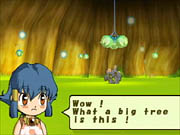
By far, the most important aspect of Monster Rancher are the monsters that you must create, train, and send into battle and competitions. Monster Rancher 3 will feature a huge assortment of creatures, and the manner in which you gain them is novel. Most are generated by CDs or DVDs: You put one into the PS2, and based on the information contained on the disc, a random monster is generated. Some discs generated predetermined special monsters, specific to the media that you've spawned them from. For example, Christmas albums in the past have created Hare monsters dressed up like Santa Claus. The list of DVDs that generate special monsters is still being put together, but expect many popular favorites and cult classics to surprise you with one-of-a-kind creatures.
In the demo version we've been able to play, five monsters are available for training: Suezo, Mocchi, Golem, Zan, and Roller. Suezo, Mocchi, and Golem were made popular by the cartoon, as well as the previous versions of the game, and they return in similar form for MR3. Zan will be popular among those who enjoy the powerful "evil-looking" creatures; he appears wicked in a way that's reminiscent of Jedah from Capcom's DarkStalkers series. Roller, on the other hand, is a polar opposite, immediately bringing to mind familiar cutesy character images like those from the '80s cartoon and toy brand Pound Puppies. Take the design of one of those sleepy-eyed dogs, make its form of locomotion a large wheel that it rolls on, and you'll get an idea of the new direction that Tecmo has taken the monsters.
The Lands of Monster Rancher 3
When you begin the game, you are introduced to Tochikan Shrine, a floating temple of sorts, reachable by crossing a rickety suspension bridge. Caretaker to this shrine is old man Bia, a crotchety type with huge hands and a penchant for giving advice (and orders). Tochikan Shrine is most like the generic city from the previous Monster Rancher games. There you will be conducting all of your monster management duties, such as spawning them from saucer stones (CDs or DVDs) or the encyclopedia--a database of previously encountered monsters. Here you will also dismiss your monsters, mix them together, and send them into hibernation.
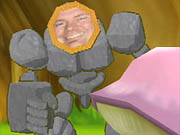
Once you've been taught the options available to you at Tochikan, you're set to venture to the training grounds. Exploring the different locales of the Monster Rancher world is part of the fun of training and raising monsters. In the demo version, Ranchers are able to raise their companions in one of five different areas; namely, Brillia, Morx, Takrama, Kalaragi, and Goat. Each of these realms offers a scenic backdrop, as well as a unique set of training exercises for honing your monster's attributes and talents.
Raising your Monster in Brillia
In this snowy training area, your monster is forced to weather frigid conditions and to thrive amongst the snowcapped mountains, vast crevasses, and brittle trees. In Brillia, your monster is challenged to, among other tasks, roll a massive snowball up a hill to its peak or knock down large crystallized ice formations. Your monster also has to scare off what appears to be a pack of polar seals. Zan is native to Brillia and thrives on the harsh conditions.
Raising your Monster in Kalaragi
Kalaragi places you and your creature in a secluded canyon, dominated by a huge waterfall. Over the waterfall, a rainbow highlights the beauty of the area, which your monster enjoys while tiptoeing across lily pads and feeding the hippos. Your monster can train in Kalaragi by hopping a series of lily pads and logs, while avoiding alligators or by showing you an impressive swan dive from the top of the waterfall into the lake below. Kalaragi is home to Roller, who fits in perfectly in this serene setting.
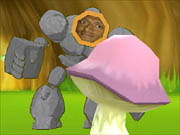
Raising your Monster in Takrama
The harsh desert is your training ground while in the wastes of Takrama. Takrama is home to an oasis, several rock formations, and other features that hallmark all sandy regions. Your monster will have to get strong quickly to feel at home training in the quicksand and general desolation. Training in Takrama can be an ordeal, as your monster may be challenged to balance on a teetering rock platform or to fight off some feisty cacti. Of all creatures, Suezo feels most at home in the desert of Takrama.
Raising your Monster in Morx
The woodlands offer you prime training conditions while in Morx, specifically, the underside of a colossal tree. Beneath this trunk that would put any redwood to shame, you can find giant mushrooms and a mass of will-o-wisps floating about, illuminating the area. Combined with the butterflies flittering about, this creates an almost faerie-like atmosphere. Despite the idyllic scenery, your monster will be hard-pressed to face the challenges of Morx, and these include bouncing off a mushroom trampoline to branches above and catching massive falling nuts to improve your defensive skills. Mocchi and Golem are both natives of Morx, as befits their benign personalities.
Raising your Monster in Goat
The most out-of-the-way training area would most likely be Goat, the undersea realm. Beneath the waterline, your monster will dally with the fishes and eels, sleep in a giant clamshell, and blow bubbles in time with the peaceful maritime melodies. Your monster, who seems to breathe as easily underwater as above, may be challenged to release a charge within an octopus statue by blowing bubbles or to knock a starfish into pesky nearby eels and fish. None of the starting creatures feel quite at home in Goat, but all can benefit from its training.
Battling your Monster
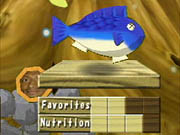
All the training, love, and discipline you and your monster share culminate in the challenge of direct conflict, in the form of rival trainer battles or league competitions. Like in the previous titles, your monster has different attacks that it can execute at different ranges, namely short, medium, and long. At each of these distances, your monster may have up to four different attacks, mapped to the face buttons on the controller. Attacks can be either power or mind based, reflected by the respective blue or red color of the onscreen indicator. Executing these moves takes "guts," a morale statistic that is measured from 0 to 99. Your monster starts with 50 guts and gains them gradually throughout the fight. The amount of guts your character has is also in direct relation to your chances of successfully executing a maneuver and should be managed strategically with this in mind. Competing monsters duke it out in cinematic fashion, and each move quickly switches the screen into a letterbox format, with close-ups, exaggerated facial animations, and over-the-top special effects, such as powerful explosions and flashes of light. In a welcome change, your movement will no longer be controlled by the shoulder buttons but by the more intuitive digital pad. While essentially similar to the battles in Monster Rancher 2, the battles in Monster Rancher 3 are fast and just as fun as the training.
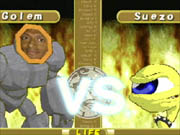
One of the newer features in Monster Rancher 3 is its support of Sony's Picture Paradise technology. Picture Paradise works with most Sony digital-imaging devices, in conjunction with the 8 MB Memory Stick. Through a USB connection on your PS2, you can connect a memory-stick reader and access images, which can be superimposed onto a number of accessories, such as crowns or masks. While the available accessories in the demo version looked a bit forced on some of the creatures, it worked wonderfully on creatures with smaller heads like Golem or Zan, effectively covering each of their faces with another, possibly your own. We were able to stick various editors' faces on the monsters, with comical results. Conceivably any image type can be used on these accessories, and the built-in image-managing software lets you resize and distort the images. You can add faces with huge chins, tiny eyes, giant foreheads, or anything in between. Sony Electronics let us know that while currently only available on Monster Rancher 3 and the Playstation 2, the technology has been licensed to software publishers such as Square for future use and may reach competing consoles.
If the demonstration version we've been able to play is any indication, fans of the series will be pleased with the many options available to those who want more diversity and a new look to the proven Monster Rancher formula. Monster Rancher 3 is currently slated for release on the Playstation 2 in the fourth quarter of 2001.
Got a news tip or want to contact us directly? Email news@gamespot.com
Join the conversation